INFINITI QX50 2019 Owner's Manual
Manufacturer: INFINITI, Model Year: 2019, Model line: QX50, Model: INFINITI QX50 2019Pages: 573, PDF Size: 7.4 MB
Page 551 of 573
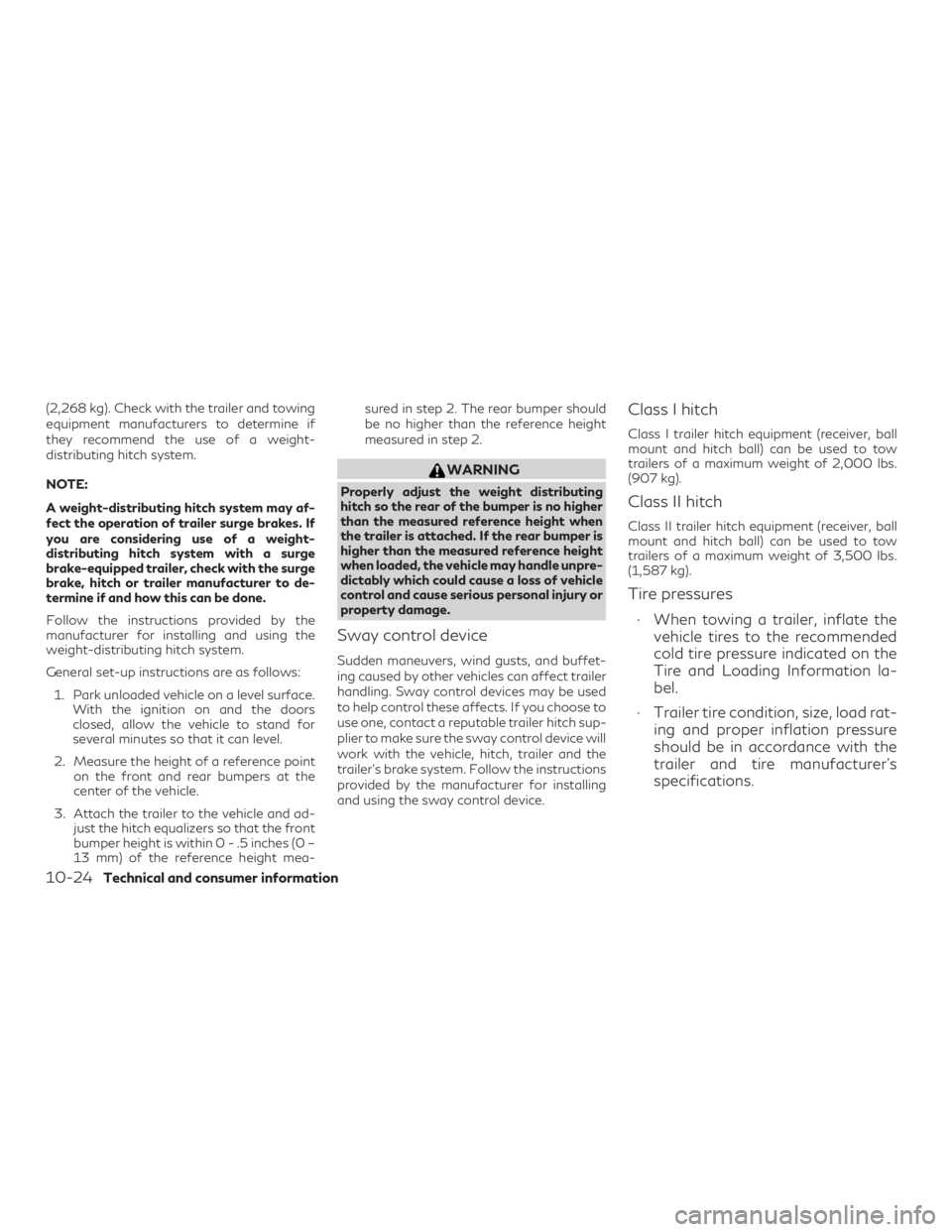
(2,268 kg). Check with the trailer and towing
equipment manufacturers to determine if
they recommend the use of a weight-
distributing hitch system.
NOTE:
A weight-distributing hitch system may af-
fect the operation of trailer surge brakes. If
you are considering use of a weight-
distributing hitch system with a surge
brake-equipped trailer, check with the surge
brake, hitch or trailer manufacturer to de-
termine if and how this can be done.
Follow the instructions provided by the
manufacturer for installing and using the
weight-distributing hitch system.
General set-up instructions are as follows:1. Park unloaded vehicle on a level surface. With the ignition on and the doors
closed, allow the vehicle to stand for
several minutes so that it can level.
2. Measure the height of a reference point on the front and rear bumpers at the
center of the vehicle.
3. Attach the trailer to the vehicle and ad- just the hitch equalizers so that the front
bumper height is within0-.5inches (0 –
13 mm) of the reference height mea- sured in step 2. The rear bumper should
be no higher than the reference height
measured in step 2.
WARNING
Properly adjust the weight distributing
hitch so the rear of the bumper is no higher
than the measured reference height when
the trailer is attached. If the rear bumper is
higher than the measured reference height
when loaded, the vehicle may handle unpre-
dictably which could cause a loss of vehicle
control and cause serious personal injury or
property damage.
Sway control device
Sudden maneuvers, wind gusts, and buffet-
ing caused by other vehicles can affect trailer
handling. Sway control devices may be used
to help control these affects. If you choose to
use one, contact a reputable trailer hitch sup-
plier to make sure the sway control device will
work with the vehicle, hitch, trailer and the
trailer’s brake system. Follow the instructions
provided by the manufacturer for installing
and using the sway control device.
Class I hitch
Class I trailer hitch equipment (receiver, ball
mount and hitch ball) can be used to tow
trailers of a maximum weight of 2,000 lbs.
(907 kg).
Class II hitch
Class II trailer hitch equipment (receiver, ball
mount and hitch ball) can be used to tow
trailers of a maximum weight of 3,500 lbs.
(1,587 kg).
Tire pressures
∙ When towing a trailer, inflate the
vehicle tires to the recommended
cold tire pressure indicated on the
Tire and Loading Information la-
bel.
∙ Trailer tire condition, size, load rat- ing and proper inflation pressure
should be in accordance with the
trailer and tire manufacturer’s
specifications.
10-24
Technical and consumer information
Page 552 of 573
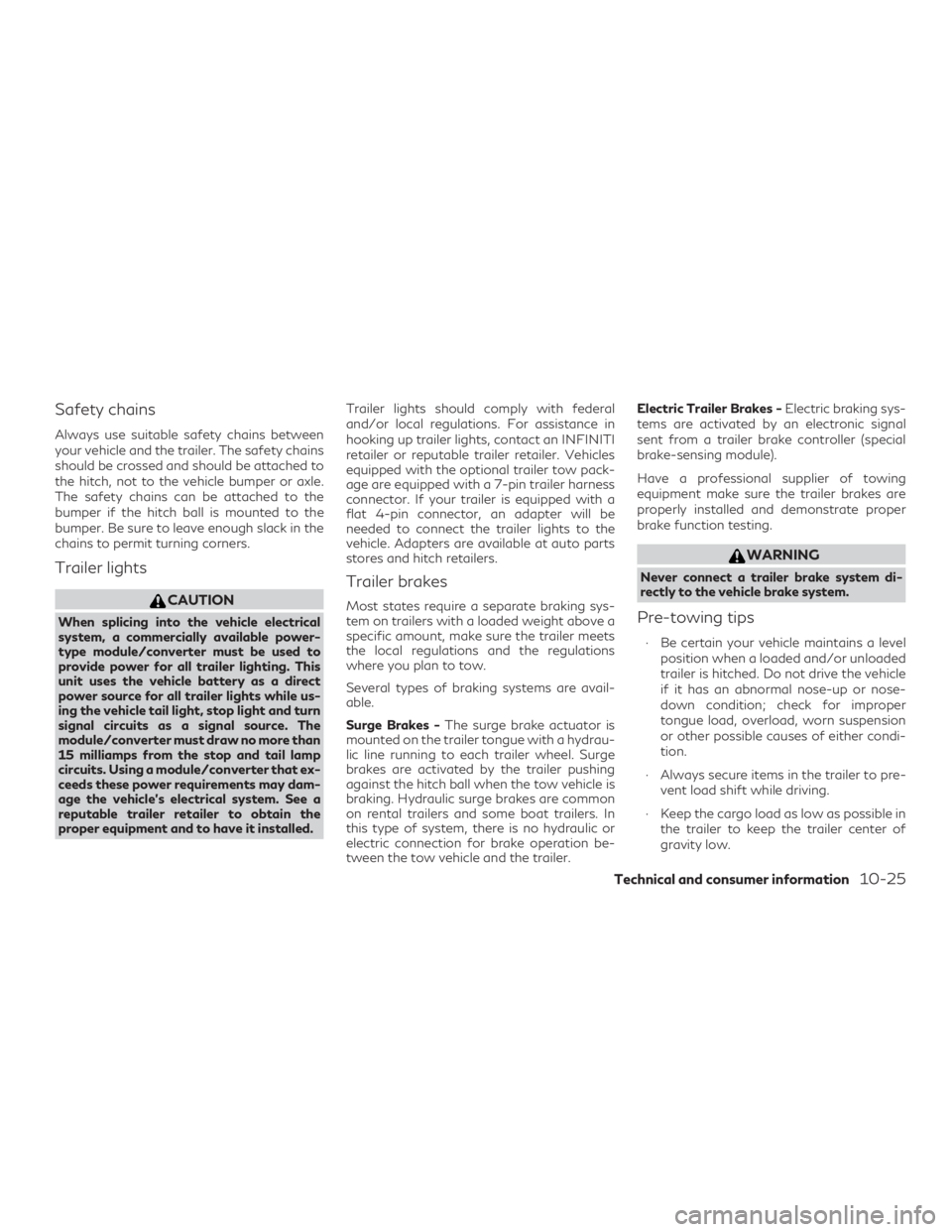
Safety chains
Always use suitable safety chains between
your vehicle and the trailer. The safety chains
should be crossed and should be attached to
the hitch, not to the vehicle bumper or axle.
The safety chains can be attached to the
bumper if the hitch ball is mounted to the
bumper. Be sure to leave enough slack in the
chains to permit turning corners.
Trailer lights
CAUTION
When splicing into the vehicle electrical
system, a commercially available power-
type module/converter must be used to
provide power for all trailer lighting. This
unit uses the vehicle battery as a direct
power source for all trailer lights while us-
ing the vehicle tail light, stop light and turn
signal circuits as a signal source. The
module/converter must draw no more than
15 milliamps from the stop and tail lamp
circuits. Using a module/converter that ex-
ceeds these power requirements may dam-
age the vehicle’s electrical system. See a
reputable trailer retailer to obtain the
proper equipment and to have it installed.Trailer lights should comply with federal
and/or local regulations. For assistance in
hooking up trailer lights, contact an INFINITI
retailer or reputable trailer retailer. Vehicles
equipped with the optional trailer tow pack-
age are equipped with a 7-pin trailer harness
connector. If your trailer is equipped with a
flat 4-pin connector, an adapter will be
needed to connect the trailer lights to the
vehicle. Adapters are available at auto parts
stores and hitch retailers.
Trailer brakes
Most states require a separate braking sys-
tem on trailers with a loaded weight above a
specific amount, make sure the trailer meets
the local regulations and the regulations
where you plan to tow.
Several types of braking systems are avail-
able.
Surge Brakes -
The surge brake actuator is
mounted on the trailer tongue with a hydrau-
lic line running to each trailer wheel. Surge
brakes are activated by the trailer pushing
against the hitch ball when the tow vehicle is
braking. Hydraulic surge brakes are common
on rental trailers and some boat trailers. In
this type of system, there is no hydraulic or
electric connection for brake operation be-
tween the tow vehicle and the trailer. Electric Trailer Brakes -
Electric braking sys-
tems are activated by an electronic signal
sent from a trailer brake controller (special
brake-sensing module).
Have a professional supplier of towing
equipment make sure the trailer brakes are
properly installed and demonstrate proper
brake function testing.
WARNING
Never connect a trailer brake system di-
rectly to the vehicle brake system.
Pre-towing tips
∙ Be certain your vehicle maintains a level position when a loaded and/or unloaded
trailer is hitched. Do not drive the vehicle
if it has an abnormal nose-up or nose-
down condition; check for improper
tongue load, overload, worn suspension
or other possible causes of either condi-
tion.
∙ Always secure items in the trailer to pre- vent load shift while driving.
∙ Keep the cargo load as low as possible in the trailer to keep the trailer center of
gravity low.
Technical and consumer information10-25
Page 553 of 573

∙ Load the trailer so approximately 60% ofthe trailer load is in the front half and
40% is in the back half. Also make sure
the load is balanced side to side.
∙ Check your hitch, trailer tire pressure, ve- hicle tire pressure, trailer light operation,
and trailer wheel lug nuts every time you
attach a trailer to the vehicle.
∙ Be certain your rearview mirrors conform to all federal, state or local regulations. If
not, install any mirrors required for tow-
ing before driving the vehicle.
∙ Determine the overall height of the ve- hicle and trailer so the required clearance
is known.
Trailer towing tips
In order to gain skill and an understanding of
the vehicle’s behavior, you should practice
turning, stopping and backing up in an area
which is free from traffic. Steering stability
and braking performance will be somewhat
different than under normal driving condi-
tions.
∙ Always secure items in the trailer to pre- vent load shift while driving. ∙ Lock the trailer hitch coupler with a pin or
lock to prevent the coupler from inadver-
tently becoming unlatched.
∙ Avoid abrupt starts, acceleration or stops.
∙ Avoid sharp turns or lane changes.
∙ Always drive your vehicle at a moderate speed.
∙ When backing up, hold the bottom of the steering wheel with one hand. Move your
hand in the direction in which you want
the trailer to go. Make small corrections
and back up slowly. If possible, have
someone guide you when you are back-
ing up.
Always block the wheels on both vehicle and
trailer when parking. Parking on a slope is not
recommended; however, if you must do so:
CAUTION
If you move the shift selector to the P
(Park) position before blocking the wheels
and applying the parking brake, transmis-
sion damage could occur.
1. Apply and hold the brake pedal. 2. Have someone place blocks on the
downhill side of the vehicle and trailer
wheels.
3. After the wheel blocks are in place, slowly release the brake pedal until the
blocks absorb the vehicle load.
4. Apply the parking brake.
5. Shift the transmission into P (Park).
6. Turn off the engine.
To drive away: 1. Start the vehicle.
2. Apply and hold the brake pedal.
3. Shift the transmission into gear.
4. Release the parking brake.
5. Drive slowly until the vehicle and trailer are clear from the blocks.
6. Apply and hold the brake pedal.
7. Have someone retrieve and store the blocks.
10-26Technical and consumer information
Page 554 of 573
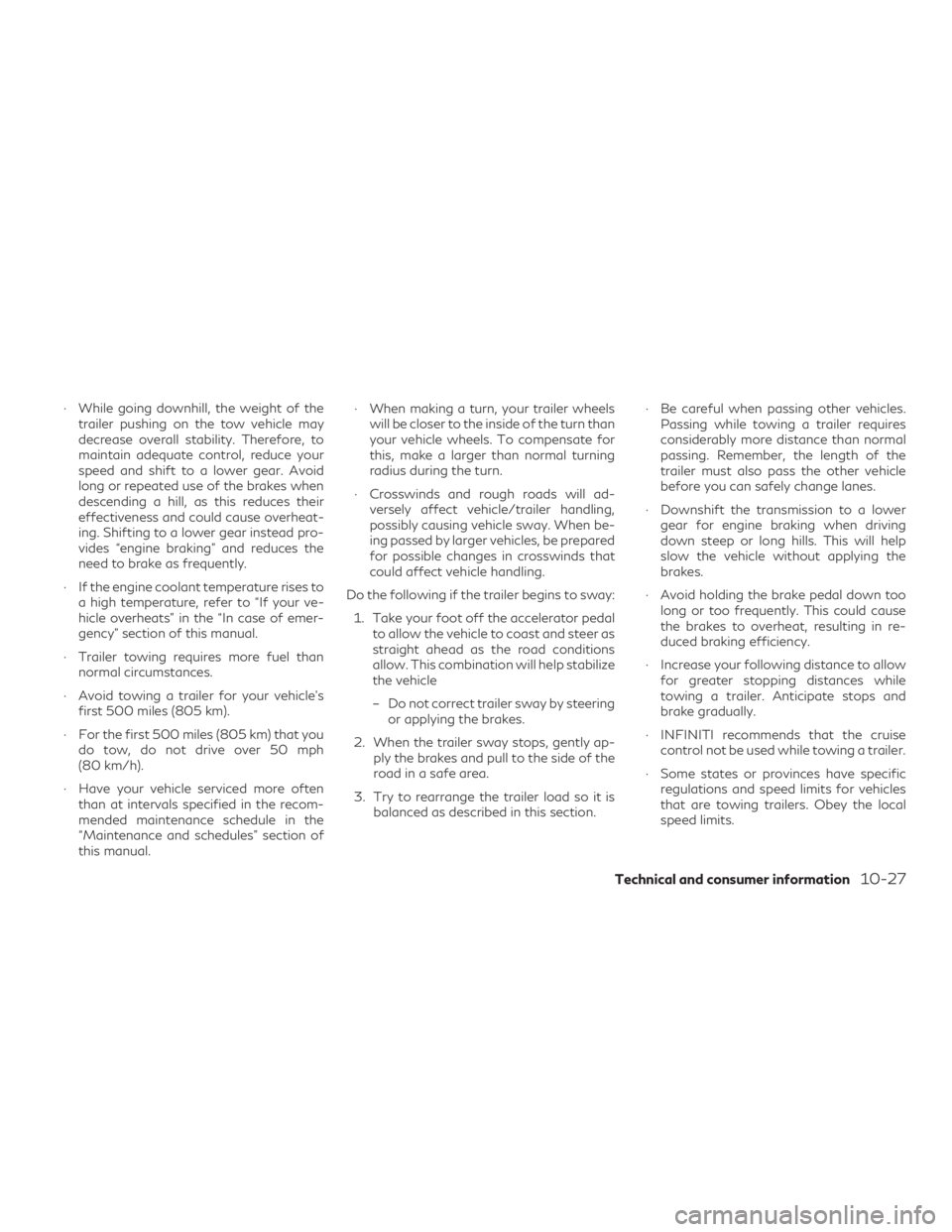
∙ While going downhill, the weight of thetrailer pushing on the tow vehicle may
decrease overall stability. Therefore, to
maintain adequate control, reduce your
speed and shift to a lower gear. Avoid
long or repeated use of the brakes when
descending a hill, as this reduces their
effectiveness and could cause overheat-
ing. Shifting to a lower gear instead pro-
vides “engine braking” and reduces the
need to brake as frequently.
∙ If the engine coolant temperature rises to a high temperature, refer to “If your ve-
hicle overheats” in the “In case of emer-
gency” section of this manual.
∙ Trailer towing requires more fuel than normal circumstances.
∙ Avoid towing a trailer for your vehicle’s first 500 miles (805 km).
∙ For the first 500 miles (805 km) that you do tow, do not drive over 50 mph
(80 km/h).
∙ Have your vehicle serviced more often than at intervals specified in the recom-
mended maintenance schedule in the
“Maintenance and schedules” section of
this manual. ∙ When making a turn, your trailer wheels
will be closer to the inside of the turn than
your vehicle wheels. To compensate for
this, make a larger than normal turning
radius during the turn.
∙ Crosswinds and rough roads will ad- versely affect vehicle/trailer handling,
possibly causing vehicle sway. When be-
ing passed by larger vehicles, be prepared
for possible changes in crosswinds that
could affect vehicle handling.
Do the following if the trailer begins to sway: 1. Take your foot off the accelerator pedal to allow the vehicle to coast and steer as
straight ahead as the road conditions
allow. This combination will help stabilize
the vehicle
– Do not correct trailer sway by steering or applying the brakes.
2. When the trailer sway stops, gently ap- ply the brakes and pull to the side of the
road in a safe area.
3. Try to rearrange the trailer load so it is balanced as described in this section. ∙ Be careful when passing other vehicles.
Passing while towing a trailer requires
considerably more distance than normal
passing. Remember, the length of the
trailer must also pass the other vehicle
before you can safely change lanes.
∙ Downshift the transmission to a lower gear for engine braking when driving
down steep or long hills. This will help
slow the vehicle without applying the
brakes.
∙ Avoid holding the brake pedal down too long or too frequently. This could cause
the brakes to overheat, resulting in re-
duced braking efficiency.
∙ Increase your following distance to allow for greater stopping distances while
towing a trailer. Anticipate stops and
brake gradually.
∙ INFINITI recommends that the cruise control not be used while towing a trailer.
∙ Some states or provinces have specific regulations and speed limits for vehicles
that are towing trailers. Obey the local
speed limits.
Technical and consumer information10-27
Page 555 of 573
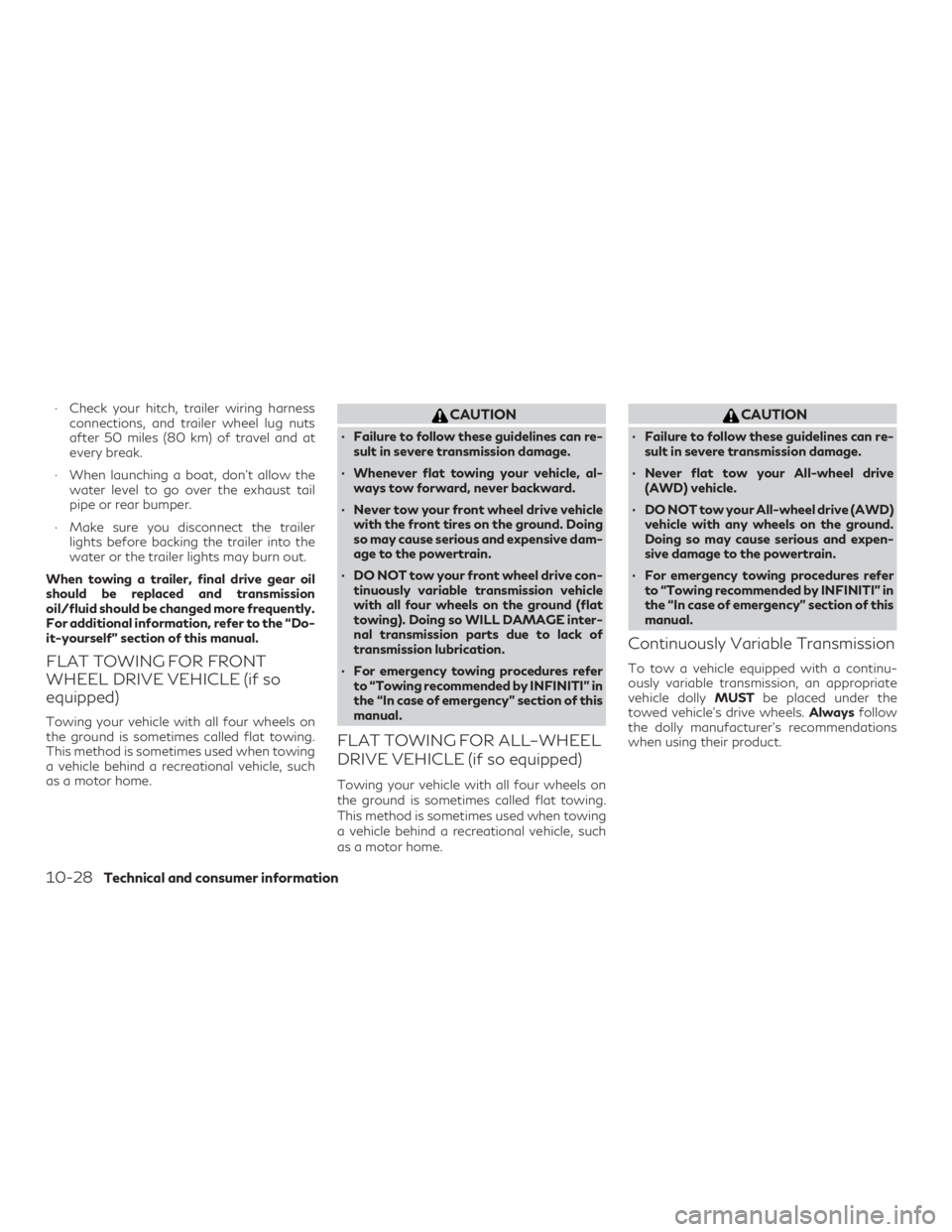
∙ Check your hitch, trailer wiring harnessconnections, and trailer wheel lug nuts
after 50 miles (80 km) of travel and at
every break.
∙ When launching a boat, don’t allow the water level to go over the exhaust tail
pipe or rear bumper.
∙ Make sure you disconnect the trailer lights before backing the trailer into the
water or the trailer lights may burn out.
When towing a trailer, final drive gear oil
should be replaced and transmission
oil/fluid should be changed more frequently.
For additional information, refer to the “Do-
it-yourself” section of this manual.
FLAT TOWING FOR FRONT
WHEEL DRIVE VEHICLE (if so
equipped)
Towing your vehicle with all four wheels on
the ground is sometimes called flat towing.
This method is sometimes used when towing
a vehicle behind a recreational vehicle, such
as a motor home.
CAUTION
∙ Failure to follow these guidelines can re- sult in severe transmission damage.
∙ Whenever flat towing your vehicle, al- ways tow forward, never backward.
∙ Never tow your front wheel drive vehicle with the front tires on the ground. Doing
so may cause serious and expensive dam-
age to the powertrain.
∙ DO NOT tow your front wheel drive con- tinuously variable transmission vehicle
with all four wheels on the ground (flat
towing). Doing so WILL DAMAGE inter-
nal transmission parts due to lack of
transmission lubrication.
∙ For emergency towing procedures refer to “Towing recommended by INFINITI” in
the “In case of emergency” section of this
manual.
FLAT TOWING FOR ALL–WHEEL
DRIVE VEHICLE (if so equipped)
Towing your vehicle with all four wheels on
the ground is sometimes called flat towing.
This method is sometimes used when towing
a vehicle behind a recreational vehicle, such
as a motor home.
CAUTION
∙ Failure to follow these guidelines can re-sult in severe transmission damage.
∙ Never flat tow your All-wheel drive (AWD) vehicle.
∙ DO NOT tow your All-wheel drive (AWD) vehicle with any wheels on the ground.
Doing so may cause serious and expen-
sive damage to the powertrain.
∙ For emergency towing procedures refer to “Towing recommended by INFINITI” in
the “In case of emergency” section of this
manual.
Continuously Variable Transmission
To tow a vehicle equipped with a continu-
ously variable transmission, an appropriate
vehicle dolly MUSTbe placed under the
towed vehicle’s drive wheels. Alwaysfollow
the dolly manufacturer’s recommendations
when using their product.
10-28Technical and consumer information
Page 556 of 573
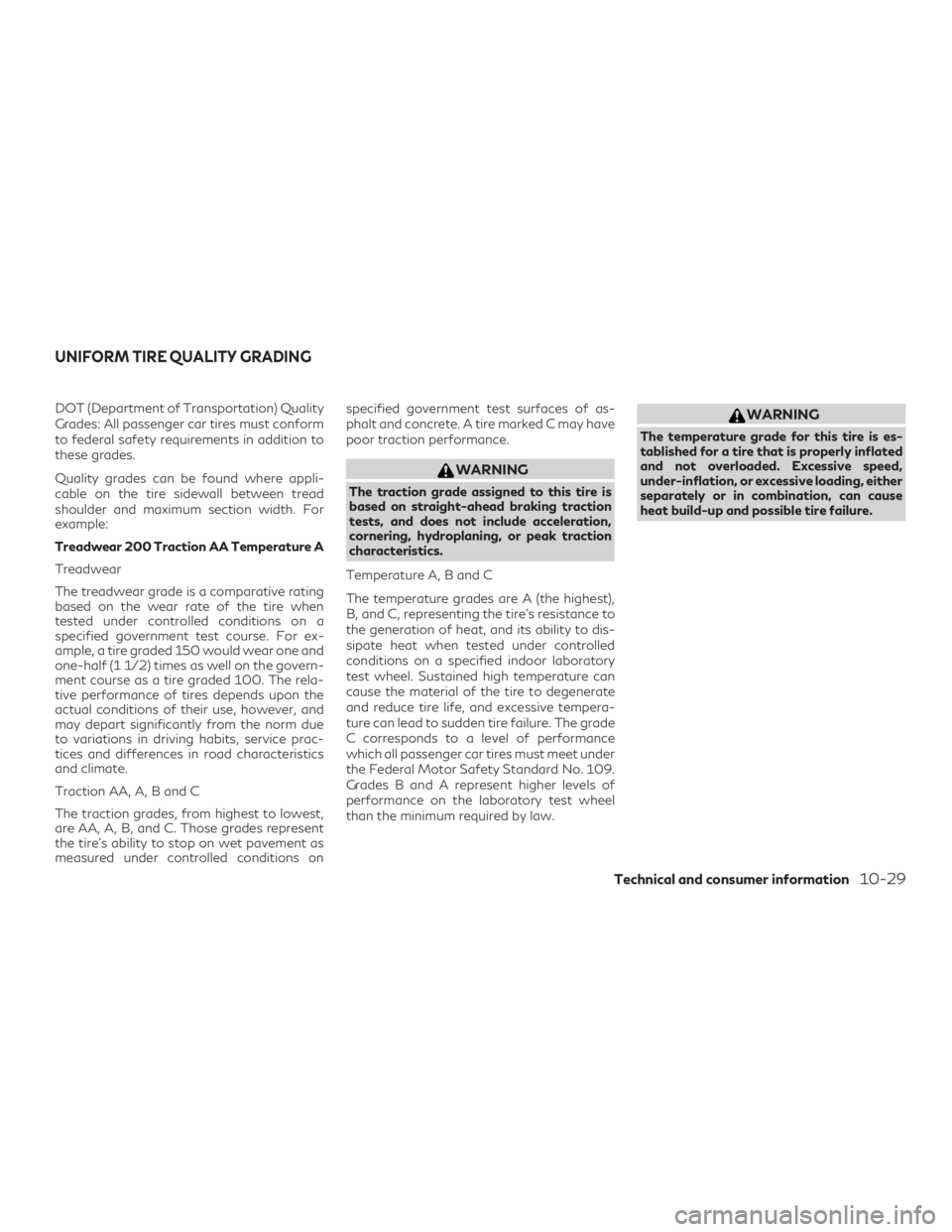
DOT (Department of Transportation) Quality
Grades: All passenger car tires must conform
to federal safety requirements in addition to
these grades.
Quality grades can be found where appli-
cable on the tire sidewall between tread
shoulder and maximum section width. For
example:
Treadwear 200 Traction AA Temperature A
Treadwear
The treadwear grade is a comparative rating
based on the wear rate of the tire when
tested under controlled conditions on a
specified government test course. For ex-
ample, a tire graded 150 would wear one and
one-half (1 1/2) times as well on the govern-
ment course as a tire graded 100. The rela-
tive performance of tires depends upon the
actual conditions of their use, however, and
may depart significantly from the norm due
to variations in driving habits, service prac-
tices and differences in road characteristics
and climate.
Traction AA, A, B and C
The traction grades, from highest to lowest,
are AA, A, B, and C. Those grades represent
the tire’s ability to stop on wet pavement as
measured under controlled conditions onspecified government test surfaces of as-
phalt and concrete. A tire marked C may have
poor traction performance.
WARNING
The traction grade assigned to this tire is
based on straight-ahead braking traction
tests, and does not include acceleration,
cornering, hydroplaning, or peak traction
characteristics.
Temperature A, B and C
The temperature grades are A (the highest),
B, and C, representing the tire’s resistance to
the generation of heat, and its ability to dis-
sipate heat when tested under controlled
conditions on a specified indoor laboratory
test wheel. Sustained high temperature can
cause the material of the tire to degenerate
and reduce tire life, and excessive tempera-
ture can lead to sudden tire failure. The grade
C corresponds to a level of performance
which all passenger car tires must meet under
the Federal Motor Safety Standard No. 109.
Grades B and A represent higher levels of
performance on the laboratory test wheel
than the minimum required by law.
WARNING
The temperature grade for this tire is es-
tablished for a tire that is properly inflated
and not overloaded. Excessive speed,
under-inflation, or excessive loading, either
separately or in combination, can cause
heat build-up and possible tire failure.
UNIFORM TIRE QUALITY GRADING
Technical and consumer information10-29
Page 557 of 573

Your INFINITI is covered by the following
emission warranties:
For USA1. Emission Defects Warranty
2. Emissions Performance Warranty
Details of these warranties may be found
with other vehicle warranties in your War-
ranty Information Booklet which comes with
your INFINITI. If you did not receive a War-
ranty Information Booklet, or it is lost, you
may obtain a replacement by writing to: ∙ INFINITI Division Nissan North America, Inc.
Consumer Affairs Department
P.O. Box 685003
Franklin, TN 37068-5003 For Canada
Emission Control System Warranty
Details of these warranties may be found
with other vehicle warranties in your War-
ranty Information Booklet which comes with
your INFINITI. If you did not receive a War-
ranty Information Booklet, or it is lost, you
may obtain a replacement by writing to:
∙ Nissan Canada Inc. 5290 Orbitor Drive
Mississauga, Ontario, L4W 4Z5For USA
If you believe that your vehicle has a
defect which could cause a crash or
could cause injury or death, you should
immediately inform the National High-
way Traffic Safety Administration
(NHTSA) in addition to notifying
INFINITI.
If NHTSA receives similar complaints,
it may open an investigation, and if it
finds that a safety defect exists in a
group of vehicles, it may order a recall
and remedy campaign. However,
NHTSA cannot become involved in in-
dividual problems between you, your
retailer, or INFINITI.
To contact NHTSA, you may call the
Vehicle Safety Hotline toll-free at
1-888-327-4236 (TTY: 1-800-424-
9153); go to http://www.safercar.gov;
or write to: Administrator, NHTSA,
400 Seventh Street, SW., Washington,
D.C. 20590. You can also obtain other
information about motor vehicle safety
from http://www.safercar.gov.
EMISSION CONTROL SYSTEM
WARRANTY REPORTING SAFETY DEFECTS
10-30Technical and consumer information
Page 558 of 573
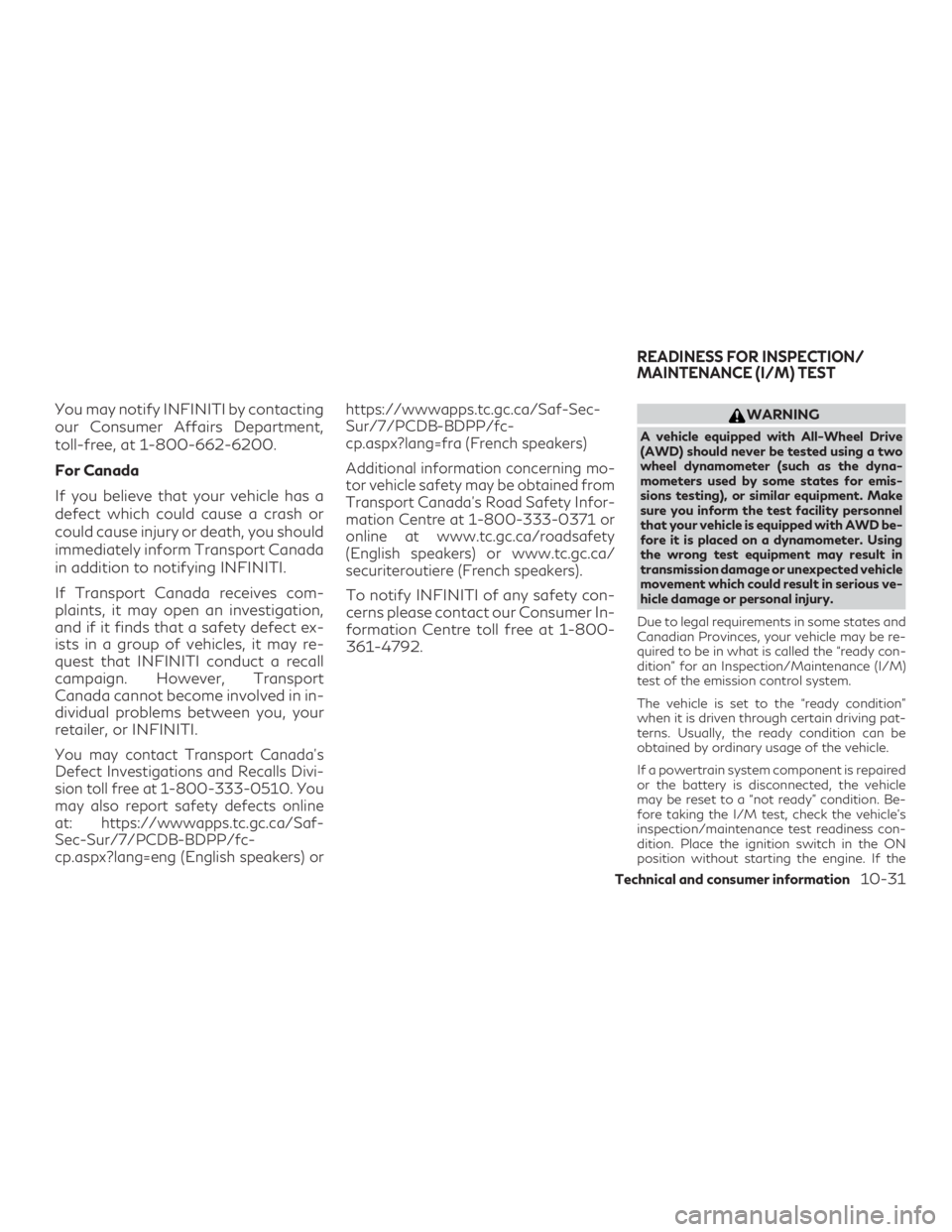
You may notify INFINITI by contacting
our Consumer Affairs Department,
toll-free, at 1-800-662-6200.
For Canada
If you believe that your vehicle has a
defect which could cause a crash or
could cause injury or death, you should
immediately inform Transport Canada
in addition to notifying INFINITI.
If Transport Canada receives com-
plaints, it may open an investigation,
and if it finds that a safety defect ex-
ists in a group of vehicles, it may re-
quest that INFINITI conduct a recall
campaign. However, Transport
Canada cannot become involved in in-
dividual problems between you, your
retailer, or INFINITI.
You may contact Transport Canada’s
Defect Investigations and Recalls Divi-
sion toll free at 1-800-333-0510. You
may also report safety defects online
at: https://wwwapps.tc.gc.ca/Saf-
Sec-Sur/7/PCDB-BDPP/fc-
cp.aspx?lang=eng (English speakers) orhttps://wwwapps.tc.gc.ca/Saf-Sec-
Sur/7/PCDB-BDPP/fc-
cp.aspx?lang=fra (French speakers)
Additional information concerning mo-
tor vehicle safety may be obtained from
Transport Canada’s Road Safety Infor-
mation Centre at 1-800-333-0371 or
online at www.tc.gc.ca/roadsafety
(English speakers) or www.tc.gc.ca/
securiteroutiere (French speakers).
To notify INFINITI of any safety con-
cerns please contact our Consumer In-
formation Centre toll free at 1-800-
361-4792.
WARNING
A vehicle equipped with All-Wheel Drive
(AWD) should never be tested using a two
wheel dynamometer (such as the dyna-
mometers used by some states for emis-
sions testing), or similar equipment. Make
sure you inform the test facility personnel
that your vehicle is equipped with AWD be-
fore it is placed on a dynamometer. Using
the wrong test equipment may result in
transmission damage or unexpected vehicle
movement which could result in serious ve-
hicle damage or personal injury.
Due to legal requirements in some states and
Canadian Provinces, your vehicle may be re-
quired to be in what is called the “ready con-
dition” for an Inspection/Maintenance (I/M)
test of the emission control system.
The vehicle is set to the “ready condition”
when it is driven through certain driving pat-
terns. Usually, the ready condition can be
obtained by ordinary usage of the vehicle.
If a powertrain system component is repaired
or the battery is disconnected, the vehicle
may be reset to a “not ready” condition. Be-
fore taking the I/M test, check the vehicle’s
inspection/maintenance test readiness con-
dition. Place the ignition switch in the ON
position without starting the engine. If the
READINESS FOR INSPECTION/
MAINTENANCE (I/M) TEST
Technical and consumer information10-31
Page 559 of 573

Malfunction Indicator Light (MIL) comes on
steady for 20 seconds and then blinks for
10 seconds , the I/M test condition is “not
ready”. If the MIL does not blink after 20 sec-
onds, the I/M test condition is “ready”. It is
recommended that you visit an INFINITI re-
tailer to set the “ready condition” or to pre-
pare the vehicle for testing.The ProPILOT Assist is equipped with an
Event Data Recording function.
The main purpose is to record, in certain crash
or near crash-like situations, such as an air
bag deployment or hitting a road obstacle,
data that will assist in understanding how a
vehicle’s systems performed. The Data re-
cording function is designed to record data
related to driver operation, vehicle dynamics
and system status for a short period of time.
The Data recording function in this vehicle is
designed to record such data as:
∙ Driver operational status of accelerator, brake, handle etc.
∙ Detection status of a vehicle ahead and lane markers
∙ Vehicle information such as vehicle speed
∙ Information on the operation of the Pro- PILOT Assist
∙ ProPILOT Assist malfunction diagnosis information
∙ Images from multi-sensing front camera (Available only when SRS air bag or IEB
system is activated) The ProPILOT Assist does not record con-
versations, sounds or images of the inside of
the vehicle.
NISSAN and third parties entrusted by
NISSAN may use the data recorded for the
purpose of improving NISSAN’s vehicle
safety performance.
NISSAN and third parties entrusted by
NISSAN will not disclose/provide the re-
corded data to a third party except:
∙ With the consent of the vehicle owner or with the consent of the lessee In re-
sponse to an official request by the po-
lice, a court of law or a government of-
fice.
∙ For use as part of NISSAN’s defense of litigation
∙ For research purposes where the data is not tied to a specific vehicle or vehicle
owner
EVENT DATA RECORDERS (EDR)
10-32Technical and consumer information
Page 560 of 573

Genuine INFINITI Service Manuals for this
model year and prior can be purchased. A
Genuine INFINITI Service Manual is the best
source of service and repair information for
your vehicle. This manual is the same one
used by the factory-trained technicians
working at INFINITI retailers. Genuine
INFINITI Owner’s Manuals can also be pur-
chased.
For USA
For current pricing and availability of Genuine
INFINITI Service Manuals, contact:
www.infiniti-techinfo.com
For current pricing and availability of Genuine
INFINITI Owner’s Manuals, contact:
1-800-247-5321
For Canada
To purchase a copy of a Genuine INFINITI
Service Manual or Owner’s Manual, for this
model year and prior, please contact your
nearest INFINITI retailer. For the phone num-
ber and location of an INFINITI retailer in
your area call the INFINITI Satisfaction Cen-
ter at 1-800-361-4792 and a bilingual
INFINITI representative will assist you.
OWNER’S MANUAL/SERVICE
MANUAL ORDER INFORMATION
Technical and consumer information10-33